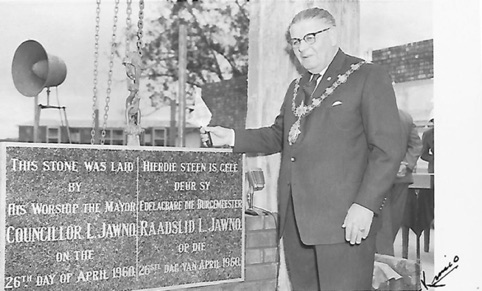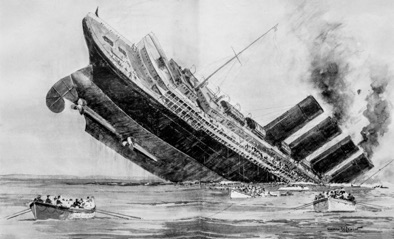Kimberley, South Africa


Kimberley ExPats Newsletter no 16
Kimberley Ex-Pats Newsletter 16 March 2018
Mayors of Kimberley: Lionel Jawno and Cecil Sussman
Kimberley Jewish citizens identified themselves from the very beginning not only with their own community, but also with every facet of civic life - local and national. This Newsletter is dedicated to two of the most recent of the six Jewish Mayors of Kimberley – Lionel Jawno 1959 – 1961 and Cecil Sussman 1964 – 1965, both of whom have new entries on family pages of the Kimberley Kehilla website. Milton Jawno, living in Jerusalem, has written about his late father Lionel. Cecil Sussman has himself sent us a lovely resume of his time as Mayor. And a bit about Ernest Oppenheimer the first mayor of the combined Beaconsfield and Kimberley municipality in 1912
Both Lionel and Cecil were Mayors in what was probably Kimberley’s heyday – specially for the Jewish community – the 1960s. Both were involved with cultural and educational matters in the city, particularly in the fortunes of the William Humphreys Art Gallery – which both the Jawno and Sussman families supported.

Milton writes: ‘One of Lionel Jawno’s first jobs was working for Mr William Benbow Humphreys who was a millionaire art collector who travelled the world collecting art after the great war and my dad had to unpack his crates of art. Later during the great depression, Mr Humphreys rented my father a small store off the market square at a reduced price and he sold a few basic groceries to earn a few pennies. In appreciation of this help, which was really not so much help but self-interest as no one wanted to rent the place in the midst of the great depression, my father later donated a huge magnificent Cape Dutch stinkwood cabinet to the William Humphreys Art Gallery in honour of old man Humphreys, and it can be seen by anyone visiting the gallery to this day. You can read Milton’s appreciation of his father here https://kehilalinks.jewishgen.org/kimberley/Jawno_Lionel.html
A room in the William Humphreys Gallery – maybe the very cabinet that Milton mentioned


During his term of Mayoral Office Cecil Sussman says ‘I tried very valiantly to get tertiary education for Kimberley, and often flew to Pretoria to interview several Ministers. In this matter, however, my pleas fell on deaf ears. I am pleased to know that to-day Kimberley has a university. I was also very outspoken on the subject of a new station for Kimberley (Cecil was Mayor when the first electric train arrived in Kimberley.) and a new market.
Of all his portfolios Cecil says that the William Humphreys Art Gallery was his most satisfying and it was also his favourite venue for civic functions. You can read about all the visiting dignitaries in those years and what was happening in Kimberley at that time on Cecil’s family page here https://kehilalinks.jewishgen.org/kimberley/Sussman_Cecil.html
Another significant Mayor of Kimberley: Ernest Oppenheimer 1912 – 1915
Ernest Oppenheimer had arrived in Kimberley in 1902, shortly after the signing of the Peace of Vereeniging. As a 22 year old, he came as a representative of Dunkelsbuhler the diamond firm and member of the Diamond Syndicate. Oppenheimer was in charge of sorting the percentage of stones allocated to the company by De Beers in accordance with the syndicate agreement and dispatching diamond parcels to Dunkelsbuhler’s London clearing house. These operations were run to a formula, which left Oppenheimer with little more than administrative responsibilities and nothing to challenge his creative mind. Within a few years of his arrival, however, Oppenheimer found an outlet for his craving to do something useful by entering the realm of town council politics.
The catalyst for such a decision was the 1907/8 economic recession. Such was the severity of the recession and the consequent drastic fall in the price of diamonds that De Beers was forced to close two mines and retrench hundreds of miners, which inevitably led to widespread poverty and hardship among Kimberley’s residents. Both Oppenheimer and his wife, May, were so moved by the residents’ distress that they became heavily involved in relief work by organising soup kitchens for the unemployed. It is said it was that experience of a Kimberley slump that influenced Oppenheimer to enter public life. And so, in 1908, Oppenheimer stood for election and, like so many magnates before him, became a Kimberley town councillor.

It was towards the end of his second year as mayor that hostilities erupted in Europe. As elected mayor of Kimberley, young Ernest Oppenheimer was much involved with recruiting soldiers, pilots and labourers when war was declared in August 1914.
Despite being of German birth (but, it should be mentioned, he had taken up British citizenship while working in London in the closing years of the nineteenth century), Oppenheimer remained quite popular among Kimberley’s residents, at least for the first few months of the war. That all changed with the sinking of the Lusitania.
Inevitably, the attack on the civilian passenger liner caused considerable outrage and sparked waves of anti-German riots in cities throughout the US and the British Empire. (In fact, it was the outrage felt by Americans, justified on the basis that most of those killed in the disaster were fellow citizens, that helped create a climate of public opinion that would later allow the US to join the war effort.) South Africa, an allied country heavily involved in the war, was not immune from such outrage and, following the publication of news of the disaster, anti-German mobs went on the rampage in Durban, Johannesburg and Kimberley.

However, the gesture was not enough to quell the rage of Kimberley’s fervently patriotic residents. Riots erupted on the evening of May 8, when groups of hooligan agitators, riled up on drink and patriotic fervour, began smashing windows, looting and destroying the property of German-owned businesses in and around Market Square. The police stood by helpless, afraid for the most part to draw their batons.
When news of the rioting, coupled with the threat that his house would be burned to the ground, reached Oppenheimer, he evacuated his residence at 7 Lodge Road and took refuge with his family in a nearby house. However, the anticipated attack did not materialise as a cordon of police headed off the mob and drove them back to the centre of town. Rioting continued until the early hours when exhaustion, rather than force, finally dispersed the mob.
However, Oppenheimer, realising the eerie stillness hanging over Kimberley was a mere façade and that the rage was far from quelled, packed his family off to the safety of Cape Town, while he settled some pressing affairs.

Unfortunately, while driving through the centre of town, he was spotted by a crowd of thugs who began to pelt his car with stones. The windscreen was smashed, and Oppenheimer suffered a severe cut on his forehead. He managed to stagger from the car, but being pursued by the mob, he dashed into the nearest building, which, as fate would have it, happened to be a convent belonging to the Holy Family. The mob dared not violate such a sanctuary, which meant Oppenheimer was safe for the time being. The nuns dressed his wound and helped him return home safely, earning his lasting gratitude. The following day, he left to join his family in Cape Town and soon thereafter the family left for London, vowing never to return to South Africa!
The sudden outburst of hatred was as sickening as it was inexplicable, and Oppenheimer would brood over it for years to come. However, had such an incident not occurred, one wonders if the events that led to the formation of Anglo American Corporation two years later would have materialised in quite the same way, if at all. We will have to consider Ernest Oppenheimer’s next foray in South Africa in another chapter.
It would be wonderful if someone would like to write up something of the other Jewish Mayors – who also seem to have been extraordinary individuals: William Sagar 1906 – 1908, Bernard Cohen 1931 – 1932 and Gustave Haberfeld 1953 – 1955 and again from 1965 – 1967?
Happy Peisach – enjoy teaching our story to our children
All good wishes from all of us – to each other for a happy Pesach to those in Kimberley and others scattered around the world. Thank you so much for your interesting comments and responses. I am only the catalyst and the Website, and the Newsletter depend so much on your interest and your contributions. I am always overjoyed to hear from you and to know that you like and appreciated what we have collectively done to memorialise the Jewish Community of Kimberley.


